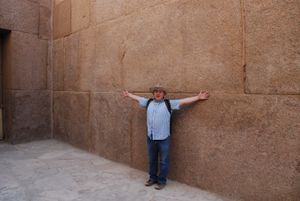Das Cheops-Projekt 3.0 geht in neue Phase der Umsetzung
Presseinformation ABORA-Projekt - 31. August 2021 - www.abora.eu
(dg) Vieles wurde in den letzten Jahren über unser Cheops-Projekt und mich berichtet. Am Anfang stand im Zentrum ausschließlich die Frage, ob die Alten Ägypter in der 4. Dynastie (2.620 - 2.500 v. Chr.) bereits Eisen kannten und dieses Metall auch zum Bau der Cheops-Pyramide nutzten. Jetzt bin ich mit meinen Forschungen soweit, ein weiteres Rätsel zum Bau der Großpyramiden von Gizeh zu lösen – das verlustfreie Trennen der großen Kalk- und Granitblöcken im alten Ägypten. Dies ist sowohl bei Ägyptologen als auch Amateurforschern eine der unbeantworteten Kardinalfragen zum Bau der großen megalithischen Strukturen. Neue Experimente in Speziallaboren sowohl in Deutschland als auch in der Schweiz lassen Hoffnung keimen, dass unser Team dieses lange ungeklärte Phänomen endlich aufklären wird!
Im neuen Cheops-Projekt 3.0 geht es um die Anfertigung von hauchdünnen, beinahe verlustfreien Trennschnitten im harten Granitgestein. Diese erforderte Metalle, die mindestens die gleiche Härte wie Granit erreichten (nach der Mohs-Härte zwischen 6.5-7.0). Alle Evidenzen, wenn wir sie richtig interpretieren, lassen nur einen Schluss zu: die Alten Ägypter nutzten primitives, aber gehärtetes Schmiedeeisen zum Bearbeiten des Granitgesteins. Sowohl das Trennen der Blöcke im Steinbruch, deren Transport als auch das Wiederzusammensetzen im Bauwerk erforderten Werkzeuge und Technologien, die mit den bisher bekannten Techniken und Metallen nicht zu gewährleisten waren. Aus diesem Grund wandte ich mich an Forschungsinstitute und Spezialfirmen, um empirische Antworten auf die Frage nach Anfertigung der Dünnschnitte, also dem Wie, zu finden.
Morgen finden dazu bei Nuoviso-TV erste Interviews für den nächsten Film mit Dr. Hans Jelitto und Gernot Geise statt. Dr. Jelitto gilt heute als „Entdecker“ der verlustfreien Trennung von Sand-, Kalk- und Granitgestein im alten Ägypten. Der Privatforscher Gernot Geise beschäftigt sich seit vielen Jahren mit der Granitbearbeitung im alten Ägypten. Darüber hinaus führen wir diesen Mittwoch wichtige Laserexperiment an eigens vorgefertigten Granitplatten an, um weitere Evidenzen zu generieren. Sie sollen als Vergleichsproben zu in antiker Methodik angefertigter Steinplatten dienen. In wenigen Wochen folgen weitere Großexperimente mit dem Fraunhofer Institut Dresden in Kooperation mit dem von-Ardenne-Institut in Dresden.
Alle Experimente – auch die bereits gemachten Ultradünnschnitte in der Schweiz – werden von Nuoviso-TV in Kooperation mit mir dokumentiert und in einem neuen Cheopsfilm 3.0 später veröffentlicht. Bitte unterstützt uns auf unseren beiden Webseiten von ABORA oder von Nuoviso-TV, damit wir den neuen Film in gewohnter Qualität anfertigen können.
Die Stein- und fugenübergreifenden Dünnschnitte hatte zuerst der Physiker und Privatforscher Dr. Hans Jelitto an den Eck- und Fundamentsteinen der Cheops-Pyramide detektiert. Hier ein Sandsteinsockel an der Cheops-Pyramide. Deutlich erkennbar die Erosionsrinnen, die ohne Versatz auf der anderen Seite des nächsten Steins weiterführen.
Zum Vergleich der Dünnschnitt bei der Firma Rototrade GmbH. Unter der Lupe erkennt man die beinahe verlustfreie Trennung der Granitplatte. Die dunklen und roten Konglomerate des Granits scheinen beinahe ohne Versatz wieder zusammengesetzt. Wir haben eine Fugenbreite von ca. 0,4-0,5 mm. Diesen Ansatz werden wir mit weiteren Partnern in Deutschland fortsetzen!!!
Kontakt: Dr. rer. nat. Dominique Görlitz; +49 163 511 57 66 oder dominique.goerlitz*at*t-online.de(bitte "*at*" durch *@* ersetzen, oder, sofern auf Ihrem System möglich, einfach den Link anklicken)
++++++++++++++++++++++++++++++++++++++++++
The Cheops project 3.0 is entering a new phase of implementation
Much has been reported about our Cheops project and me in recent years. At the beginning, the focus was solely on the question of whether the ancient Egyptians already knew iron in the 4th dynasty (2.620 - 2.500 v. Chr.) and also used this metal to build the Cheops pyramid. Now, with my research, I am ready to solve another riddle for the construction of the Great Pyramids of Giza - the loss-free separation of the great limestone and granite blocks in ancient Egypt. This is one of the unanswered cardinal questions for both Egyptologists and amateur researchers about the construction of the great megalithic structures. New experiments in special laboratories in both Germany and Switzerland give rise to hope that our team and I will finally clear up this long unexplained phenomenon!
The new Cheops project 3.0 is about the production of wafer-thin, almost loss-free separating cuts in hard granite rock. This required metals that achieved at least the same hardness as granite (according to the Mohs hardness between 6.5-7.0). All the evidence, if we interpret it correctly, allows only one conclusion: the ancient Egyptians used primitive but hardened wrought iron to work the granite rock. Separating the blocks in the quarry, transporting them and reassembling them in the building required tools and technologies that could not be guaranteed with the previously known techniques and metals. For this reason, I turned to research institutes and specialist companies to find empirical answers to the question of how to make thin sections, i.e. how.
Tomorrow the first interviews for the next film with Dr. Hans Jelitto and Gernot Geise. Today Dr. Jelitto is considered to be the "discoverer" of the loss-free separation of sand, limestone and granite rock in ancient Egypt. The private researcher Gernot Geise has been working on granite processing in ancient Egypt for many years. In addition, this Wednesday we are conducting important laser experiments on specially prepared granite slabs in order to generate further evidence. They are intended to serve as comparative samples for stone slabs made using the ancient method. Further large-scale experiments will follow in a few weeks with the Fraunhofer Institute Dresden in cooperation with the von Ardenne Institute in Dresden.
All experiments - including the ultra-thin sections already made in Switzerland - are documented by Nuoviso-TV in cooperation with me and later published in a new Cheopsfilm 3.0. Please support us on our two websites from ABORA or Nuoviso-TV so that we can produce the new film in the usual quality.





